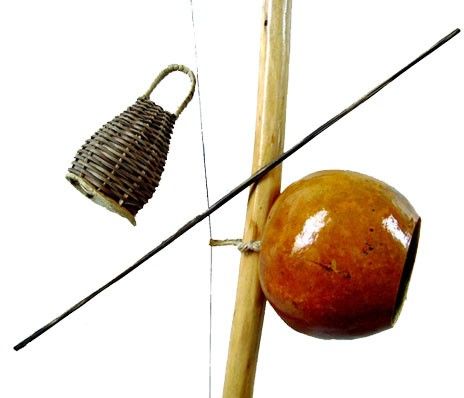The berimbau is a musical bow of African origin. It consists of an arc of biriba wood about 1.6 meters long and 2.5 centimeters thick, called the verga. The lower end of the verga is carved into a peg to attach the wire (arame), which is then stretched tight over the top end of the verga, bending it. The arame is a steel wire taken from the inside of a car tire; before there were tires, animal entrails or vegetable fibers were used to string the berimbau. The resonator attached towards the bottom of the verga is called thecabaça. It is a dried, hollowed-out gourd, typically of the specieslagenaria vulgaris.
The instrument is held in the left hand with the opening of the cabaça facing the body. It is balanced on the pinky finger, and an old Brazilian coin (dobrão) or stone is held between the left thumb and forefinger; this serves to press against the arame and alter the pitch. The right hand holds the caxixi, a rattle woven of wicker with seeds, seashells, or pebbles inside, as well as the baqueta, a thin wooden stick used to strike the arame.
 Berimbaus come in three sizes. The one with the largest cabaça and most flexible verga is called the gunga. It has the deepest sound, and in the roda it is responsible for keeping the basic rhythm. The berimbau médio has a medium-sized cabaça. In the roda, it plays the inverse of the gunga’s rhythm. The viola or violinha has the smallest cabaça, the stiffestverga, and the highest, sharpest sound. Its role is to improvise, embellish, and play variations on the rhythm.
Berimbaus come in three sizes. The one with the largest cabaça and most flexible verga is called the gunga. It has the deepest sound, and in the roda it is responsible for keeping the basic rhythm. The berimbau médio has a medium-sized cabaça. In the roda, it plays the inverse of the gunga’s rhythm. The viola or violinha has the smallest cabaça, the stiffestverga, and the highest, sharpest sound. Its role is to improvise, embellish, and play variations on the rhythm.
There are many legends surrounding the berimbau; the most interesting tells about a beautiful young girl who was attacked and killed by a villain while drinking water from a stream. Her enchanted body transformed into a berimbau: her body became the arc of wood, her hair became thearame, her cupped hands became the cabaça, and her cries of sadness and pain became the instrument’s melancholy sound.

